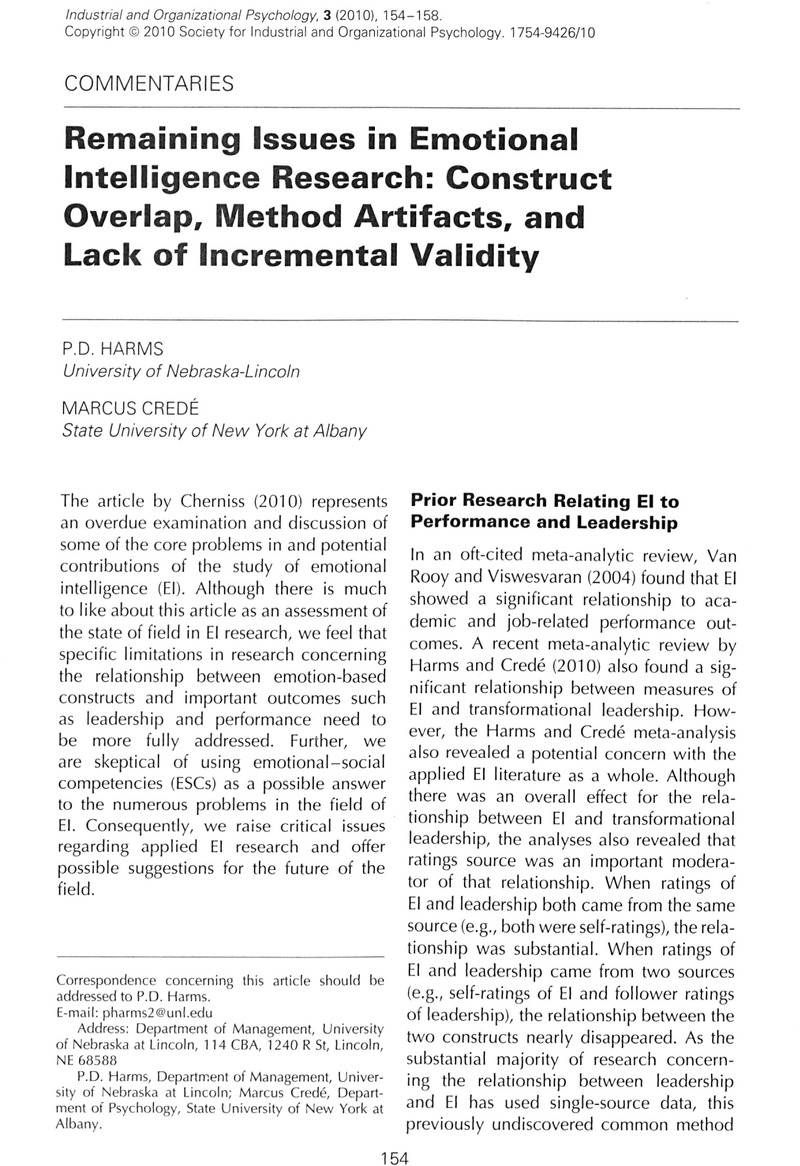Crossref Citations
This article has been cited by the following publications. This list is generated based on data provided by Crossref.
Cherniss, Cary
2010.
Emotional Intelligence: New Insights and Further Clarifications.
Industrial and Organizational Psychology,
Vol. 3,
Issue. 2,
p.
183.
Iliescu, Dragos
Ilie, Alexandra
Ispas, Dan
and
Ion, Andrei
2012.
Emotional Intelligence in Personnel Selection: Applicant reactions, criterion, and incremental validity.
International Journal of Selection and Assessment,
Vol. 20,
Issue. 3,
p.
347.
Cavazotte, Flavia
Moreno, Valter
and
Hickmann, Mateus
2012.
Effects of leader intelligence, personality and emotional intelligence on transformational leadership and managerial performance.
The Leadership Quarterly,
Vol. 23,
Issue. 3,
p.
443.
Zaccaro, Stephen J.
2012.
Individual differences and leadership: Contributions to a third tipping point.
The Leadership Quarterly,
Vol. 23,
Issue. 4,
p.
718.
Kluemper, Donald H.
DeGroot, Timothy
and
Choi, Sungwon
2013.
Emotion Management Ability.
Journal of Management,
Vol. 39,
Issue. 4,
p.
878.
Ryan, Ann Marie
and
Ployhart, Robert E.
2014.
A Century of Selection.
Annual Review of Psychology,
Vol. 65,
Issue. 1,
p.
693.
Dietz, Joerg
Antonakis, John
Hoffrage, Ulrich
Krings, Franciska
Marewski, Julian N.
and
Zehnder, Christian
2014.
Teaching Evidence-Based Management With A Focus on Producing Local Evidence.
Academy of Management Learning & Education,
Vol. 13,
Issue. 3,
p.
397.
Andrei, Federica
Mancini, Giacomo
Trombini, Elena
Baldaro, Bruno
and
Russo, P.M.
2014.
Testing the incremental validity of Trait Emotional Intelligence: Evidence from an Italian sample of adolescents.
Personality and Individual Differences,
Vol. 64,
Issue. ,
p.
24.
McCleskey, Jim
2014.
Emotional intelligence and leadership.
International Journal of Organizational Analysis,
Vol. 22,
Issue. 1,
p.
76.
Feldt, Ronald
Lindley, Kyla
Louison, Rebecca
Roe, Allison
Timm, Megan
and
Utinkova, Nikola
2015.
Incremental Validity of the Subscales of the Emotional Regulation Related to Testing Scale for Predicting Test Anxiety.
Canadian Journal of School Psychology,
Vol. 30,
Issue. 3,
p.
193.
Uslu, Fatma
and
Oklay, Erdem
2015.
Leadership and Organizational Outcomes.
p.
81.
Michelangelo, Lori
2015.
The overall impact of emotional intelligence on nursing students and nursing.
Asia-Pacific Journal of Oncology Nursing,
Vol. 2,
Issue. 2,
p.
118.
Andrei, Federica
Siegling, A. B.
Aloe, Ariel M.
Baldaro, Bruno
and
Petrides, K. V.
2016.
The Incremental Validity of the Trait Emotional Intelligence Questionnaire (TEIQue): A Systematic Review and Meta-Analysis.
Journal of Personality Assessment,
Vol. 98,
Issue. 3,
p.
261.
Ttofi, Maria M.
Farrington, David P.
Piquero, Alex R.
Lösel, Friedrich
DeLisi, Matthew
and
Murray, Joseph
2016.
Intelligence as a protective factor against offending: A meta-analytic review of prospective longitudinal studies.
Journal of Criminal Justice,
Vol. 45,
Issue. ,
p.
4.
Smith, Ryan
Alkozei, Anna
and
Killgore, William D. S.
2017.
Contributions of self-report and performance-based individual differences measures of social cognitive ability to large-scale neural network functioning.
Brain Imaging and Behavior,
Vol. 11,
Issue. 3,
p.
685.
Petrides, K. V.
Sanchez-Ruiz, Maria-Jose
Siegling, Alex B.
Saklofske, Donald H.
and
Mavroveli, Stella
2018.
Emotional Intelligence in Education.
p.
49.
Zaccaro, Stephen J.
Green, Jennifer P.
Dubrow, Samantha
and
Kolze, MaryJo
2018.
Leader individual differences, situational parameters, and leadership outcomes: A comprehensive review and integration.
The Leadership Quarterly,
Vol. 29,
Issue. 1,
p.
2.
Boohene, Rosemond
Gyimah, Regina Appiah
and
Osei, Martin Boakye
2019.
Social capital and SME performance: the moderating role of emotional intelligence.
Journal of Entrepreneurship in Emerging Economies,
Vol. 12,
Issue. 1,
p.
79.
Cuéllar Molina, Deybbi
Déniz-Déniz, Mª Cruz
and
García-Cabrera, Antonia M.
2019.
The HR decision-maker’s emotional intelligence and SME performance.
Management Research Review,
Vol. 43,
Issue. 1,
p.
56.
Segrin, Chris
and
Flora, Jeanne
2019.
Fostering social and emotional intelligence: What are the best current strategies in parenting?.
Social and Personality Psychology Compass,
Vol. 13,
Issue. 3,



